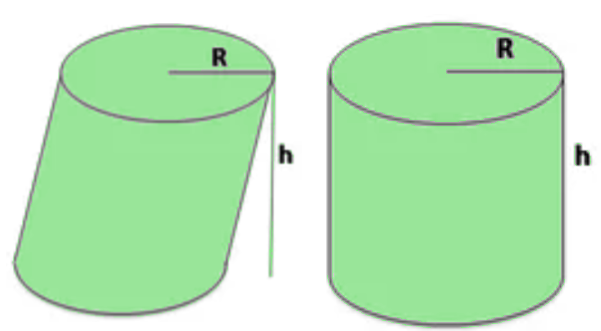 Home
Home
 Back
Back

To find the radius of a cylinder based on its surface area, you also need to know the height of the cylinder: r and h.
Using the Surface Area FormulaSubstitute the height h into the surface area formula for a cylinder:
\( A = 2\pi r^2 + 2\pi r h \)
To solve for the radius \( r \), rearrange the equation to set it equal to zero: \( 2\pi r^2 + 2\pi r h - A = 0 \). Note that this is a quadratic equation in terms of \( r \).
Solving the Quadratic EquationUse the quadratic formula to solve for \( r \):
\[ r = \frac{-2\pi h \pm \sqrt{(2\pi h)^2 - 4(2\pi)(-A)}}{2(2\pi)} \]
Simplifying this, we get:
\[ r = \frac{-2\pi h \pm \sqrt{4\pi^2 h^2 + 8\pi A}}{4\pi} \]
Since the radius \( r \) must be positive, we only take the positive root of this quadratic equation:
\[ r = \frac{-2\pi h + \sqrt{4\pi^2 h^2 + 8\pi A}}{4\pi} \]
This is the formula for finding the radius of a cylinder based on its surface area and height.
A cylinder is a solid bounded by a cylindrical surface and two parallel planes. Imagine it as a solid physical tin with lids on top and bottom. To calculate its volume, you need to know two parameters: the radius (or diameter) and height.
The formula for the volume of a cylinder is:
cylinder volume = π × cylinder radius² × cylinder height
A cylinder volume calculator can help you find the volume of right, hollow, and oblique cylinders.
A hollow cylinder, also called a cylindrical shell, is a three-dimensional region bounded by two right circular cylinders having the same axis and two parallel annular bases perpendicular to the cylinders' common axis. Think of a drinking straw or a pipe – the hollow cylinder is made of plastic, metal, or other material.
The formula for the volume of a hollow cylinder is:
cylinder_volume = π × (R² - r²) × cylinder_height
where R is the external radius, and r is the internal radius.
Alternatively, you can use the external diameter (D) and internal diameter (d) of a hollow cylinder with this formula:
cylinder_volume = π × [(D² - d²)/4] × cylinder_height
Cylinders are commonly used in various fields and their specifications vary based on the application. Below are some typical cylinder specifications:
In Construction and Engineering| Diameter (D) & Height (H) | Applications |
|---|---|
| Φ150×300mm | Large-scale projects such as hydropower, bridges, tunnels, and high-rise buildings. |
| Φ100×200mm | Medium and small-scale projects such as houses, roads, and plazas. |
| Φ75×150mm | Small projects such as floor slabs and masonry. |
| Dimensions | Applications |
|---|---|
| 10×10mm to 60×60mm | Manufacturing wear-resistant parts and components such as wear-resistant lining plates and pipelines. |
| Half-cylinders (e.g., 20×10mm half, 20×20 half) | Special-shaped and sized wear-resistant parts. |
| Connected columns (e.g., 31×31mm and 31×31mm with groove half-cylinders) | Wear-resistant parts requiring connection and fixation. |
Cylinders are also widely used in other fields such as machinery manufacturing, electronics, and chemicals. Specifications in these fields are usually determined based on specific application requirements and design specifications.